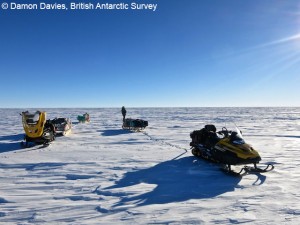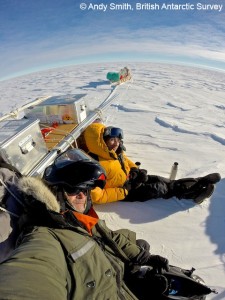Damon Davies, a postgraduate student in Geosciences from the University of Edinburgh, has returned to Pine Island Glacier for a second year to help carry out probes of the ice. Here he reports on his first few days back on the glacier:
Greetings from a cold and windy Pine Island Glacier. The second iSTAR traverse is well underway with the science progressing well. So far two 50m ice cores have been drilled, four Neutron Probe snow density profiles completed, two GPS stations uplifted and the seismic surveys are just getting started.
I’m fortunate to be embarking on my second iSTAR traverse. Back in Edinburgh after a successful first season my memories of Pine Island soon began to feel like a dream, photos didn’t quite seem real. Now I find myself back in the caboose as if I never left. I barely had time to adjust before being thrown back into the great white expanse of the West Antarctic Ice Sheet.
We landed at Rothera Research Station on the Antarctic Peninsula where I was greeted with the news that I would be flying down to Pine Island Glacier the next morning. I boarded the Twin Otter aircraft and headed into the wild interior of the continent with mechanics Mark and Tim and Traverse Leader James to help out as a ‘shovel monkey’, digging up the traverse vehicles and equipment from their over-winter slumber. I’d made the journey from London to 75°S in 72 hours, barely able to take in the breathtaking mountains and icebergs of the Peninsula en route South.
A week of shovelling later, 5800L fuel bladders were filled, ski-doos and snow tractors revived and the caboose up and running as the rest of the 12 strong team began to fly in. My first involvement in science this season would involve travelling as a two-man team with Science Leader Andy Smith, to obtain snow density profiles from three sites. The plan was to break from the main traverse and travel 130 km by ski-doo carrying our science gear, food and pyramid tent on wooden ‘Nansen’ sleds, rejoining the traverse a few days later.
The going was tough, travelling over rough snow surfaces in temperatures plummeting as low as -30°C. Keeping warm required five layers of clothing and stopping every 5 km to allow blood back into our extremities. Thermos flasks of hot drinks, fudge cake and enthusiastic wind milling of arms proved the most effective tactics against the elements.
The most gruelling day involved a 50 km leg that ended up taking 10 hours driving through the sunlit night, leaving at 6pm and arriving at our destination at 4am. The highlight of the journey for me was witnessing a streak of light followed by a flash tearing through the atmosphere as a meteor ended its long journey in the dead of the Antarctic night sky. Our journey that day ended in the comfort of the pyramid tent around the warm glow of the primus stove with a bag of rehydrated chilli con carne for breakfast, 21 hours after waking the previous morning.
Five days after leaving the main traverse, we had successfully completed our cold and windy escapade completing all the science work we set out to achieve and were welcomed back to camp with a coffee and walnut cake freshly baked by Izzy in the iSTAR caboose. It was great to experience a more traditional method of Antarctic field travel and I look forward to what lies ahead on the rest of our journey across Pine Island Glacier.


